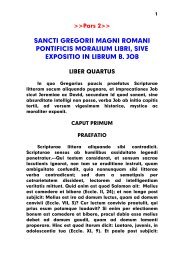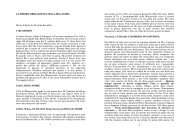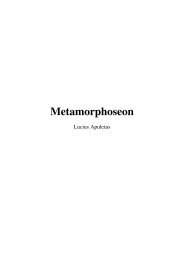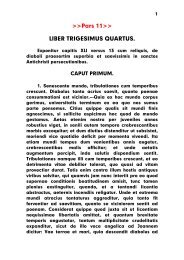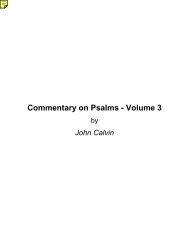The Dolorous Passion of Our Lord Jesus Christ. - documenta ...
The Dolorous Passion of Our Lord Jesus Christ. - documenta ...
The Dolorous Passion of Our Lord Jesus Christ. - documenta ...
You also want an ePaper? Increase the reach of your titles
YUMPU automatically turns print PDFs into web optimized ePapers that Google loves.
<strong>The</strong> <strong>Dolorous</strong> <strong>Passion</strong> <strong>of</strong> <strong>Our</strong> <strong>Lord</strong> <strong>Jesus</strong> <strong>Christ</strong>.Anne Catherine Emmerich216apparently well in health; and she answered, ‘I always feel thus when Mid-Lent comes, for thenthe Church sings with Isaias in the introit at Mass; “Rejoice, O, Jerusalem, and come together allyou that love her; rejoice with joy, you that have been in sorrow, that you may exult and be filledfrom the breasts <strong>of</strong> your consolation.” Mid-Lent Sunday is consequently a day <strong>of</strong> rejoicing; andyou may likewise remember that, in the gospel <strong>of</strong> this day, the Church relates how our <strong>Lord</strong> fedfive thousand men with five loaves and two fishes, <strong>of</strong> which twelve baskets <strong>of</strong> fragments remained,consequently we ought to rejoice.’She likewise added, that our <strong>Lord</strong> had deigned to visit her on that day in the Holy Communion,and that she always felt especial spiritual consolation when she received him on that particular day<strong>of</strong> the year. <strong>The</strong> friend cast his eyes on the calendar <strong>of</strong> the diocese <strong>of</strong> Munster, and saw that on thatday they not only kept Mid-Lent Sunday, but likewise the Feast <strong>of</strong> St. Joseph, the foster-father <strong>of</strong>our <strong>Lord</strong>; he was not aware <strong>of</strong> this before, because in other places the feast <strong>of</strong> St. Joseph is kept onthe 19th, and he remarked this circumstance to Sister Emmerich, and asked her whether she didnot think that was the cause <strong>of</strong> her speaking about Joseph. She answered that she was perfectlyaware <strong>of</strong> its being the feast <strong>of</strong> the foster-father <strong>of</strong> <strong>Jesus</strong>, but that she had not been thinking <strong>of</strong> thechild <strong>of</strong> that name. However, a moment after, she suddenly remembered what her thoughts hadbeen the day before, and explained to her friend that the moment the feast <strong>of</strong> St. Joseph began, hervisions <strong>of</strong> the sorrowful mysteries <strong>of</strong> the <strong>Passion</strong> ceased, and were superseded by totally differentscenes, in which St. Joseph appeared under the form <strong>of</strong> a child, and that it was to him that the wordswe have mentioned above were addressed.We found that when she received these communications the vision was <strong>of</strong>ten in the form <strong>of</strong> a child,especially in those cases when an artist would have made use <strong>of</strong> that simile to express his ideas. If,for instance, the accomplishment <strong>of</strong> some Scripture prophecy was being shown to her, she <strong>of</strong>tensaw by the side <strong>of</strong> the illustration a child, who clearly designated the characteristics <strong>of</strong> such or sucha prophet, by his position, his dress, and the manner in which he held in his hand and waved to andfro the prophetic roll appended to a staff.217Sometimes, when she was in extreme suffering, a beautiful child, dressed in green, with a calm andserene countenance, would approach, and seat himself in a posture <strong>of</strong> resignation at the side <strong>of</strong> herbed, allowing himself to be moved from one side to the other, or even put down on to the ground,without the smallest opposition and constantly looking at her affectionately and consoling her. If,when quite prostrate from illness and the sufferings <strong>of</strong> others which she had taken upon herself,she entered into communication with a saint, either by participation in the celebration <strong>of</strong> his feast,or from his relics being brought to her, she sometimes saw passages <strong>of</strong> the childhood <strong>of</strong> this saint,and at others the most terrible scenes <strong>of</strong> his martyrdom. In her greatest sufferings she was usuallyconsoled, instructed, or reproved (whichever the occasion called for) by apparitions under the form<strong>of</strong> children. Sometimes, when totally overcome by trouble and distress, she would fall asleep, andbe carried back in imagination to the scenes and perils <strong>of</strong> her childhood. She sometimes dreamed,as her exclamations and gestures demonstrated, that she was once more a little country girl <strong>of</strong> fiveyears old, climbing over a hedge, caught in the briars, and weeping with fear.<strong>The</strong>se scenes <strong>of</strong> her childhood were always events which had really occurred, and the words whichescaped her showed what was passing in her mind. She would exclaim (as if repeating the words124






